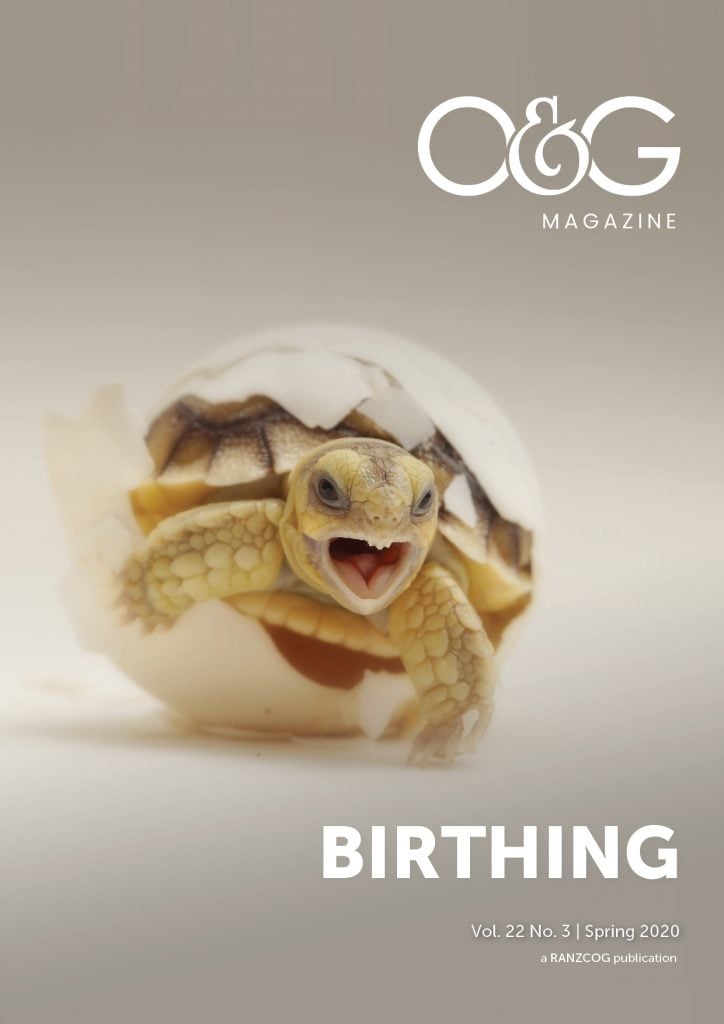Nowadays, debate on the best time to deliver largely focuses on the timing of vaginal delivery. The timing of caesarean section is less controversial, ideally occurring at 39 weeks unless dictated by individual clinical circumstances, where the risk to mother or baby associated with delaying delivery until 39 weeks justify the increased neonatal respiratory morbidity associated with earlier delivery.1
The practice of obstetrics has changed enormously over the last few decades. I would recommend all O&Gs in Australia and New Zealand read Dr Margaret Smith’s fascinating autobiography, Now & Then: A Gynaecologist’s Journey,2 to get a feel for mid-20th century obstetrics. It is now rare not to have a very accurate due date, know the number of fetuses, position of the placenta and whether any structural abnormalities are present. While vaginal delivery has existed since the dawn of time, it is worth considering some of our entrenched, ‘no-brainer’, practices. One of these is the idea that the spontaneous onset of labour is ideal. This idea initially evolved from traditional practice, where the due date was often uncertain, the ability to alter the course of a pregnancy and/or manage iatrogenic complications were more limited.
This support for spontaneous labour subsequently found support, incorrectly, from studies comparing women undergoing induction of labour (IOL) with women in spontaneous labour.3 4 Choosing the time of spontaneous labour is not a choice any women will ever have. Later retrospective cohort studies comparing IOL with expectant management from the same gestation showed a lower rate of both caesarean delivery and neonatal morbidity.5 6
Following this, randomised controlled trials for specific high-risk groups showed no difference in caesarean section rates with IOL for women 35 years or older7 and significantly more vaginal deliveries with less shoulder dystocia and associated co-morbidities with IOL for fetal macrosomia.8 Induction after 36 weeks for gestational hypertension or mild pre-eclampsia showed better maternal outcomes.9 IOL in postdates pregnancy results in fewer caesareans compared to expectant management.10
The ARRIVE trial published in August 2018 is the final piece to this puzzle, looking at induction for low-risk women with no traditional indication for intervention. The authors showed a significant reduction in caesarean delivery with IOL, 18.6% versus 22.2%, RR 0.84, CI 0.76-0.93, as well as less hypertensive disease.11
What of the fetal outcome though? Are babies born at later gestations better placed for later life? Preventing pregnancies progressing beyond 42 weeks is associated with lower rates of stillbirth,12 and a reduction in perinatal mortality is seen with IOL at every gestation from 37 to 41 weeks.5 Cochrane shows a policy of IOL at or beyond term is associated with a significantly lower risk of all-cause perinatal death (RR 0.33) and stillbirth (RR 0.33), as well as caesarean section (RR 0.92). 426 induced deliveries are needed to prevent one perinatal death.13
What about long-term neurological outcomes for children after induced labour? Educational achievement has been shown to be the same for children induced at 39 or 40 weeks as those whose mothers were managed expectantly past 39 weeks.14
Which patient group benefits the most from IOL? When we look at the median gestation at delivery between the IOL and the expectant management group in ARRIVE, the difference is 39+4 vs 40+0, significantly different but still not much in a 280 day pregnancy. The real difference is in the interquartile range, 39+1 to 39+5 for IOL vs 39+3 to 40+7 for expectant management. It is by intervening in those pregnancies that would otherwise have progressed furthest where the biggest benefit will be found. Unfortunately, there is no way of knowing exactly when labour will start.
There is evidence in women with hypertensive disease at term showing the greatest benefit of IOL is for those that have the most unfavourable cervixes.15 It is those women who are destined to progress furthest past their due date that are most likely to benefit from IOL, benefiting from decreased risks of caesarean section, hypertensive disease, shoulder dystocia, stillbirth and perinatal death.
As someone who has routinely tried to induce all mothers by their due date for over six years, my initial fear was patients delivering via non-elective caesarean section as a direct result of my intervention and failure to establish in labour. My personal experience is that getting women into labour is not as hard as we have been led to believe. The failure to establish labour is a sign of the unready uterus programmed to deliver at a much later gestation. Considered labour ward management is needed here and often a little more time to allow the uterus and cervix to upload oxytocin receptors and ready itself for labour is needed. If there is obstruction in labour at 39 weeks, it is hard to see how waiting longer will help this. Even more importantly, those fetuses that declare their unhappiness in labour and are delivered via emergency caesarean represent a vulnerable population, at risk of stillbirth with ongoing gestation. Those women who will always have laboured easily still do so and, in my experience, if a nullipara is induced and has a baby in her arms by lunchtime she is never unhappy. What the induction process ends up doing is standardising labour, removing most of the unpredictability from the process. You suddenly find that meconium and pathological CTGs are rare events.
One of the side benefits of routine induction for low risk women is that IOL for higher risk patients becomes easier. I routinely use the same technique for preterm pregnancies needing induction with pre-eclampsia or growth restriction as I do for low-risk term pregnancies. Similarly, I have had a 45-year-old nullipara deliver very nicely vaginally with a 39-week induction recently.
The science on timing of delivery is clear. Selling this to a public led to believe that induction is almost invariably a bad thing is a challenge for us all as a profession. The art of obstetrics will evolve with time and one of the major tools in everyone’s kit will have to be the ability to develop methods of induction acceptable to women, their families and also our midwifery colleagues.
References
- RANZCOG. Timing of elective caesarean section at term. C-Obs 23. 2018. Available from: https://ranzcog.edu.au/statements-guidelines/obstetrics/timing-of-elective-caesarean-section-at-term-(c-ob
- Smith M. Now & Then: A Gynaecologist’s Journey. Crumplestone Press, 2010.
- Vardo J. Maternal and neonatal morbidity among nulliparous women undergoing elective induction of labor. J Reprod Med. 2011;56:25-30.
- Dunne C. Outcomes of elective labour induction and elective caesarean section in low-risk pregnancies between 37 and 41 weeks’ gestation. J Obstet Gynaecol Can. 2009;31:1124-30.
- Stock S et al. Outcomes of elective induction of labour compared with expectant management: population based study. BMJ. 2012:344:e2838
- Middleton P et al. Induction of labour for improving birth outcomes for women at or beyond term. Cochrane Database Syst Rev. 2018;5(5):CD004945.
- Randomized Trial of Labor Induction in Women 35 Years of Age or Older. N Engl J Med. 2016;374:813-22.
- Boulvain M et al. Induction of labour versus expectant management for large-for-date fetuses: a randomised controlled trial. Lancet. 2015:385:2600-5.
- Koopmans CM, et al. Induction of labour versus expectant monitoring for gestational hypertension or mild pre-eclampsia after 36 weeks’ gestation (HYPITAT): a multicentre, open-label randomised controlled trial. Lancet. 2009;374:979-88.
- Hannah M, et al. Induction of labor compared with serial antenatal monitoring in post-term pregnancy. N Engl J Med. 1992;326:1587-92.
- Grobman W, et al. Labor Induction versus Expectant Management in Low-Risk Nulliparous Women. N Engl J Med. 2018:379:513-23.
- Hedegaard et al. Reduction in stillbirths at term after new birth induction paradigm: results of a national intervention. BMJ Open. 2014;4:e005785.
- Middleton P et al. Induction of labour for improving birth outcomes for women at or beyond term. Cochrane Database Syst Rev. 2018;5(5):CD004945.
- Werner et al. Association of Term Labor Induction vs Expectant Management With Child Academic Outcomes. JAMA Network Open. 2020;3(4):e202503.
- Tajik P, et al. Should cervical favourability play a role in the decision for labour induction in gestational hypertension or mild pre-eclampsia at term? An exploratory analysis of the HYPITAT trial. BJOG. 2012;119:1123-30.






Leave a Reply